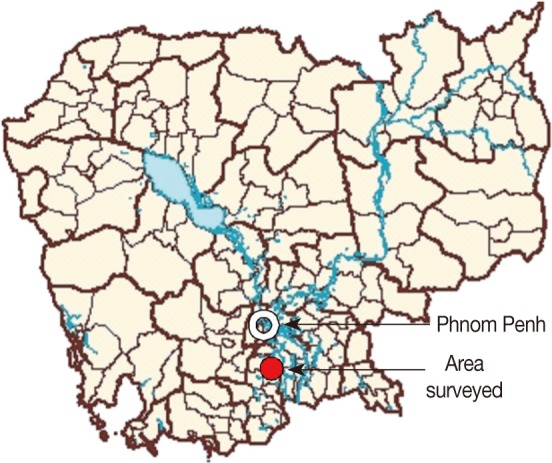High Prevalence of Opisthorchis viverrini Infection in a Riparian Population in Takeo Province, Cambodia
Article information
Abstract
Opisthorchis viverrini infection was found to be highly prevalent in 3 riverside villages (Ang Svay Chek A, B, and C) of the Prey Kabas District, Takeo Province. This area is located in the southern part of Cambodia, where the recovery of adult O. viverrini worms was recently reported. From May 2006 until May 2010, fecal examinations were performed on a total of 1,799 villagers using the Kato-Katz thick smear technique. In the 3 villages, the overall positive rate for helminth eggs ranged from 51.7 to 59.0% (av. 57.4%), and the percentage positive for O. viverrini was 46.4-50.6% (47.5%). Other helminths detected included hookworms (13.2%), echinostomes (2.9%), Trichuris trichiura (1.3%), Ascaris lumbricoides (0.6%), and Taenia spp. (0.06%). The prevalence of O. viverrini eggs appeared to reflect a lower infection in younger individuals (<20 years) than in the adult population (>20 years). Men (50.4%) revealed a significantly higher (P=0.02) prevalence than women (44.3%). The Ang Svay Chek villages of the Prey Kabas District, Takeo Province, Cambodia have been confirmed to be a highly endemic area for human O. viverrini infection.
Five species of small liver flukes belonging to the family Opisthorchiidae are known to infect humans around the world, Clonorchis sinensis, Opisthorchis viverrini, Opisthorchis felineus, Metorchis conjunctus, and Metorchis orientalis [1,2]. Among them, C. sinensis and O. viverrini are highly important in clinical and public health points of view. They are capable of causing chronic inflammation in the bile duct leading to cholangitis, and cirrhosis of the liver, and may also be a predisposing factor for cholangiocarcinoma [1,3]. O. viverrini is highly prevalent among people in the Indochina peninsula, including Thailand, Lao PDR, and Vietnam [4]. Cambodia is also included in this list based on the discovery of small trematode eggs (20-32 µm in length) in the feces of Cambodian people [3,5-8], and also after recovery of adult O. viverrini flukes from 6 human cases who resided in the Prey Kabas District [9]. Thus, Takeo Province, Cambodia appears to be an endemic area for human opisthorchiasis [9]. However, no detailed data on its prevalence and endemicity have been reported.
From May 2006 until May 2010, we conducted stool surveys in riverside villages of the Ang Svay Chek area in the Prey Kabas District, where we found a high occurrence of O. viverrini eggs. Here, we report that O. viverrini is highly endemic in riparian areas of Takeo Province, a southern part of Cambodia, through which the Mekong River flows.
The surveyed regions included 3 villages (Ang Svay Chek A, B, and C) in the Prey Kabas District, an area approximately 45 km south of Phnom Penh (Fig. 1). Nearly 45,000 people reside in this District. Most villagers are farmers or fishermen. During the actual survey times (May 2006, November 2008, and May 2010), a total of 1,799 fecal samples were collected from the subjects (aged 1 though 94 years), 1 sample per each person, and transported to the Centre for Parasitology, Entomology, and Malaria Control in Phnom Penh, Cambodia. The Kato-Katz thick smear technique was used to detect helminth eggs. Fecal examinations of the villagers were sanctioned by the Ministry of Health, Cambodia, under the agreement of the Korea-Cambodia International Collaboration on Intestinal Parasite Control in Cambodia (2006-2011). Prevalence differences between men and women were statistically determined using the z-test.

Map showing the surveyed area (Ang Svay Chek villages, Prey Kabas District) in Takeo Province, southern Cambodia.
The overall positive rates for helminth eggs, for 1 or more species, were found to be high but not significantly different between each of the 3 villages (A, B, and C), which was in the range of 51.7-59.0% (av. 57.4%) (Table 1). The most commonly observed eggs were those of O. viverrini/minute intestinal flukes (MIF) (most of these here were regarded as O. viverrini), with the prevalence ranging from 46.4 to 50.6% by village (av. 47.5%). Other helminths included Ascaris lumbricoides 0.4-0.7% (av. 0.6%), hookworms 1.9-16.0% (av. 13.2%), Trichuris trichiura 1.0-2.8% (av. 1.3%), Taenia spp. 0.0-0.07% (av. 0.06%), and echinostomes 2.6-3.9% (av. 2.9%). Eggs of Enterobius vermicularis, Hymenolepis nana, and H. diminuta were also noted each in a few cases (Table 1).

Prevalence of intestinal helminths among people in Ang Svay Chek villages, the Prey Kabas District, Takeo Province, Cambodia as determined by the Kato-Katz fecal examination from May 2006 to May 2010
O. viverrini showed differential prevalences according to age and sex (Table 2). Younger individuals (<20 years) showed lower prevalences (27.4-40.0%) than the adult population (>20 years) (59.3-68.1%). Men revealed a significantly higher (P=0.02) prevalence (50.4%) than women (44.3%). For another parasite, A. lumbricoides, all 9 positive cases occurred in children and young adults under 20 years of age. Hookworm infections appeared to be age independent until the age 60, when the prevalence increased.

Age and sex prevalence of intestinal helminths among people in Ang Svay Chek village C, the Prey Kabas District, Takeo Province, Cambodia as determined by the Kato-Katz fecal examination (May 2010)
The present study confirmed, for the first time, the high endemicity of human O. viverrini infections in a southern area of Cambodia. The prevalence was assessed as high as almost 50% among the surveyed people. Previous reports occasionally suggested the occurrence of O. viverrini infection in Cambodia based on recovery of small trematode eggs in the feces from the population. For example, from 1981 through 1982, 2 of 102 Cambodian refugees in the USA were found to be positive for C. sinensis, but which was probably O. viverrini eggs [5]. A small number of cases were later confirmed positive for eggs in Kracheh in 1999 [6], Kampongcham in 2002 [7], and Stung Treng in 2003 [8]. Subsequently, in 2010, adult O. viverrini flukes have been detected in 6 human cases in the Prey Kabas District of Takeo Province [9].
Small trematode eggs may result from infections by various species of hepatic and intestinal flukes [1]. In Thailand, Vietnam, and Lao PDR, O. viverrini, C. sinensis, and MIF which include Haplorchis taichui, Haplorchis pumilio, Haplorchis yokogawai, Prosthodendrium molenkampi, and Phaneropsolus bonnei, may be responsible for this type of eggs [10-13]. In Lao PDR and Thailand, mixed infections with O. viverrini and MIF are a common finding [10-13]. However, the relative prevalence of each fluke species varies by locality. For example, in Lao PDR, O. viverrini was the predominant species in Vientiane Municipality, whereas H. taichui predominated in Saravane Province [10]. In a mountainous area of Phongsaly Province, Lao PDR, no O. viverrini worms were recovered from 10 villagers examined, while many H. taichui and H. yokogawai worms were recovered [13]. Therefore, in Cambodia, presence of human infections with MIF, including Haplorchis spp. and lecithodendriids (P. molenkampi and P. bonnei), here in Takeo Province or elsewhere, cannot be completely ruled out.
Data on fish intermediate hosts supporting the endemicity of O. viverrini in Takeo Province have been reported. During 2007-2008, O. viverrini metacercariae were detected in various species of freshwater fish, including Hampala dispar and Puntius brevis, caught in the vicinity of Lake 500, a water reservoir located near the border of Takeo and Kandal Provinces [14]. The metacercariae were identified through both cytochrome c oxidase subunit 1 sequencing and confirmation of adult flukes after experimental infection to hamsters [14]. Another fish study was performed in Kandal Province which borders Takeo Province; here, the metacercariae of O. viverrini were identified by detecting the mitochondrial nad1 gene [15]. In our previous study on fish hosts caught near the Ang Svay Chek villages, we confirmed the presence of O. viverrini metacercariae in Puntioplites proctozysron [9]. In that study, average 10 metacercariae per fish were collected, and the metacercariae were confirmed by recovery of adult flukes from infected hamsters. Because this fish species is popularly eaten by the villagers, it is suspected as a source of human infections.
ACKNOWLEDGMENTS
We thank the staff of Centre for Parasitology, Entomology, and Malaria Control, Phnom Penh, Cambodia, and also Ji-Hae Kang, Jun-Yong Hong, In-Sam Kim, Yeo-Hyun Baek, and Soo-Mi Park, Korea Association of Health Promotion, for their help in preparing and reading the Kato-Katz fecal smears.